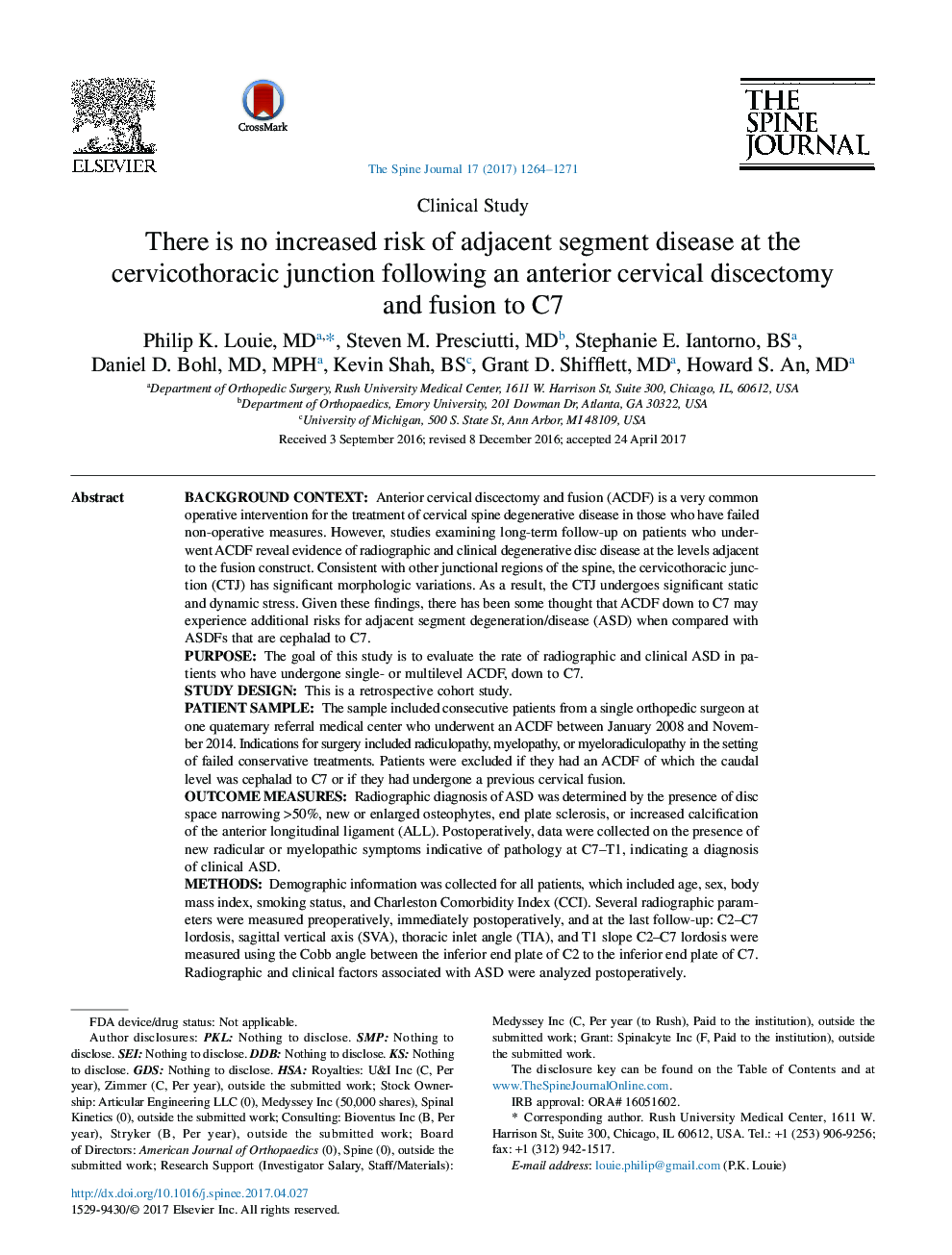| Article ID | Journal | Published Year | Pages | File Type |
|---|---|---|---|---|
| 5713048 | The Spine Journal | 2017 | 8 Pages |
Background ContextAnterior cervical discectomy and fusion (ACDF) is a very common operative intervention for the treatment of cervical spine degenerative disease in those who have failed non-operative measures. However, studies examining long-term follow-up on patients who underwent ACDF reveal evidence of radiographic and clinical degenerative disc disease at the levels adjacent to the fusion construct. Consistent with other junctional regions of the spine, the cervicothoracic junction (CTJ) has significant morphologic variations. As a result, the CTJ undergoes significant static and dynamic stress. Given these findings, there has been some thought that ACDF down to C7 may experience additional risks for adjacent segment degeneration/disease (ASD) when compared with ASDFs that are cephalad to C7.PurposeThe goal of this study is to evaluate the rate of radiographic and clinical ASD in patients who have undergone single- or multilevel ACDF, down to C7.Study DesignThis is a retrospective cohort study.Patient SampleThe sample included consecutive patients from a single orthopedic surgeon at one quaternary referral medical center who underwent an ACDF between January 2008 and November 2014. Indications for surgery included radiculopathy, myelopathy, or myeloradiculopathy in the setting of failed conservative treatments. Patients were excluded if they had an ACDF of which the caudal level was cephalad to C7 or if they had undergone a previous cervical fusion.Outcome MeasuresRadiographic diagnosis of ASD was determined by the presence of disc space narrowing >50%, new or enlarged osteophytes, end plate sclerosis, or increased calcification of the anterior longitudinal ligament (ALL). Postoperatively, data were collected on the presence of new radicular or myelopathic symptoms indicative of pathology at C7-T1, indicating a diagnosis of clinical ASD.MethodsDemographic information was collected for all patients, which included age, sex, body mass index, smoking status, and Charleston Comorbidity Index (CCI). Several radiographic parameters were measured preoperatively, immediately postoperatively, and at the last follow-up: C2-C7 lordosis, sagittal vertical axis (SVA), thoracic inlet angle (TIA), and T1 slope C2-C7 lordosis were measured using the Cobb angle between the inferior end plate of C2 to the inferior end plate of C7. Radiographic and clinical factors associated with ASD were analyzed postoperatively.ResultsFour patients (4.8%) presented with clinical evidence of ASD, all of whom also showed signs of radiographic ASD and improved with conservative measures. No patients underwent reoperation for ASD at the C7-T1 junction. Thirty patients (36.1%) presented radiographic evidence of ASD. These were generally older (54.4 vs. 48.4 years; p=.014). There were neither significant differences in radiographic parameters nor between single- versus multilevel ACDFs and the development of ASD.ConclusionsThe cervicothoracic junction may present with vulnerability to ASD given the junctional biomechanics. However, this study provides evidence that an ACDF with the caudal level of C7 does not incur additional risk of ASD, showing similar outcomes to ACDFs at other levels.
